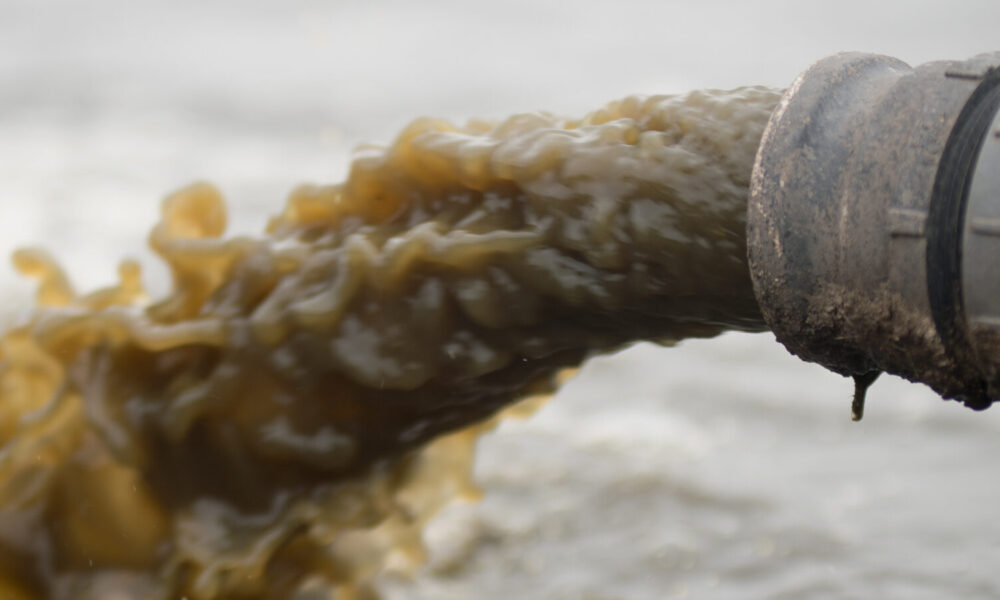Industrial meat and poultry slaughterhouses dump millions of pounds of pollutants into the nation’s waters every year. The federal Clean Water Act directs the US Environmental Protection Agency (EPA) to set and enforce the rules that regulate this pollution. But the current rules, which were enacted two decades ago, are woefully inadequate at curbing the environmental and human impacts of this dirty water deluge. Fortunately, at the end of 2023, the EPA proposed strengthening the current standards—though the old rules still apply while the proposed changes are being debated.
From slaughter to dirty water
Wastewater from slaughterhouses—produced as workers wash animals, clean meat, sanitize equipment, and scrub work areas—carries pollutants into waterways when it is dumped directly into rivers, streams, or lakes, or when it is sprayed onto farmland, where the contaminants run off into surface waters or trickle down into the groundwater.
Slaughterhouse water pollution includes nitrogen and phosphorus that can stimulate harmful algal growth, suck up oxygen, and create “dead zones” that jeopardize aquatic life. The EPA identified the meat and poultry industry as the source of “the highest phosphorus levels and second highest nitrogen levels of all industrial categories.” Slaughterhouse wastewater also contains suspended solids like fat, grease, and other animal parts and byproducts. These solids, along with animal waste, further deplete oxygen in waterways and introduce pathogens like E. coli.
This contamination poses human health risks, particularly for people living close to slaughterhouses. For example, harmful algal blooms can cause respiratory symptoms like pneumonia, bronchitis, and asthma attacks. Previous research exposed how slaughterhouse wastewater sprayed onto farm fields contaminated drinking water wells in Delaware with fecal bacteria and nitrates. Drinking water contaminated with nitrates, which are nitrogen compounds, raises the risk of colorectal cancer and thyroid disease. When pregnant people drink nitrate-contaminated water, it increases the risk of central nervous system defects in infants. Earlier research connected infant formula made with nitrate-contaminated water with a higher risk for the blood disorder methemoglobinemia in very young children.
The environmental injustice of slaughterhouse pollution
Earthjustice attorney Alexis Andiman notes that slaughterhouse pollution “disproportionately harms under-resourced communities, low-income communities, and communities of color”—the same communities that bear the heaviest brunt of all pollution in the United States. The EPA found that almost 75% of slaughterhouse wastewater discharges occur within one mile of communities wrestling with environmental, health, social, and/or economic burdens. The environmental racism experienced by these communities means that curbing water pollution from slaughterhouses is a matter of environmental justice, the principle that everyone deserves to live in a clean and healthy environment.
The EPA’s proposed changes
Despite the EPA’s own evidence of environmental injustice and significant water pollution by the meat and poultry industry, it took a lawsuit by environmental advocates to spur the agency to propose new limits on this pollution for the first time in 20 years.
The EPA’s proposed rule—called the Clean Water Act Effluent Limitations Guidelines and Standards for the Meat and Poultry Products Point Source Category—strengthens existing standards by reducing the amount of nitrogen pollution slaughterhouses are allowed to release (industrial wastewater that carries this pollution is called “effluent”). It expands current standards by establishing first-ever limits for phosphorus and pre-treatment standards for oil and grease, total suspended solids, and biochemical oxygen demand. The proposal also introduces regulations for E. coli bacteria and wastewater with high salt content.
In addition to strengthening limits on pollutants, the proposed changes would also apply to more slaughterhouses. Currently, only about 300 of the roughly 7,000 US meat and poultry slaughter facilities are required to follow the EPA’s effluent guidelines. Under the proposed rule, the new limits would apply to approximately 850 facilities.
The EPA estimates that the proposed standards will result in about 100 million fewer pounds per year of nitrogen, phosphorus, and other contaminants polluting our waterways. Importantly, the agency affirmed that affordable technologies exist to help slaughterhouses meet the proposed standards.
Towards cleaner water for all
Technology has advanced considerably since the regulations governing slaughterhouse water pollution were introduced, debated, and enacted 20 years ago, and the availability of affordable, effective technology like biological nutrient removal for reducing nitrogen concentrations means that the EPA can and should require slaughterhouses to reduce or eliminate the pollution they are currently dumping into our waterways.
Of course, stricter limits on water pollution only work if they are enforced. Recent research by the Environmental Integrity Project on slaughterhouses that paid little to no fines for their illegal water pollution between 2016 and 2018 concluded that “penalties and enforcements are rare.” The EPA should commit to enforcing slaughterhouse water pollution regulations to the fullest extent, because enforcement has a ripple effect: it reduces future violations by the fined company and deters other companies from committing violations.
As part of the regulatory process, the EPA is required to solicit and consider public comments on proposed rule changes. Because the harms of slaughterhouse water pollution disproportionately impact specific people and communities, the agency should actively seek guidance and input on the proposed rule from those most affected, including slaughterhouse employees and downstream communities. For example, the EPA could hold community meetings with residents in Delaware, Florida, and Illinois, where slaughterhouse water pollution has contaminated drinking water wells, killed hundreds of thousands of fish, and poisoned lakes, rivers, and streams, preventing community members from fishing, swimming, and enjoying their local blue spaces.
Speak up for clean water
The EPA is holding public hearings this month on the proposed rules regulating slaughterhouse water pollution. The Union of Concerned Scientists will be testifying in support of strengthening these rules, and you can too! Head over to the EPA’s proposed rule website and register to provide comments. Together, we can encourage our government to take decisive action against rampant slaughterhouse water pollution and towards cleaner water for all.

